Home care
A healthy, vigorous plant is characterized by bright color of leaves, dense skin, flexible and elastic stems. Leaves should be evenly distributed over the entire length of the stem.
If it seems to you that the leaves grow too rarely or too far from the roots, most likely it is necessary to change the conditions of maintenance and care.
Pruning is also a good way to rejuvenate and rejuvenate your plant.
The soil for the plant is usually bought ready-made. Experienced English ivy lovers often make their own soil mix. There are many recipes for preparing soil, but they differ depending on the geographic area and the natural materials available.
It is best to feed ivy with 50 percent liquid houseplant fertilizer. The frequency of feeding depends on the condition of the flower, the average value is considered 1 time in 3 or 4 months.
How to care immediately after purchase?
For this, plants choose a non-hot room, a well-lit place. If it is a windowsill, make sure the plants are protected from drafts.
Due to the fact that ivy vines decorate the room, the flower pot is often placed higher: at the level of human growth, for example. Often this decision is justified, since in this position good illumination is ensured. However, it is more difficult to monitor plant health, soil moisture and leaf color. Read more about ivy care here.
Pruning
An overgrown plant can be pruned in mid-spring. This treatment will only strengthen the health and stamina of the ivy. The resulting branches - shoots take root easily and give rise to new plants.
Watering
Like most plants, the life cycle of ivy is divided into vegetative - a period of intensive growth and a period of rest, or wintering.
In the cold season, watering is minimized, but with an increase in daylight hours, they carefully return to normal.
During the growing season, ivy should be watered relatively frequently to keep the soil slightly damp.
In the summer, in the heat, it is good to spray the plant. Ivy is very fond of humid air and fog, natural or artificial. Also, in summer, when the windows are open, a lot of dust can quickly build up on the leaves. It is enough to wipe the leaves with clean water 1-2 times a week using any soft cloth or sponge.
Temperature
Loves moderate temperatures, feels great in cool rooms.
Hypothermia may be indicated by the appearance of a light pinkish border along the edges of the leaves.
The recommended range is from +10 to + 18˚С, the minimum allowable value is + 5˚С.
Lighting
The plant loves bright enough, but soft light - diffused, like in a forest or in other natural conditions. Direct rays of the sun have a detrimental effect on ivy.
The lack of lighting is expressed in the fact that the leaves begin to lose light spots and patterns: they turn pale, blurred around the edges and gradually disappear. In general, variegated ivy species require more light than solid green plants.
If you notice that the drawing on the leaves has lost its clarity, move the flower to a dark corner for a day or two, and then put it in a brightly lit place. Light fabrics are best protected from direct sunlight; you can use frosted glass or a screen made of tissue paper.
IMPORTANT! Signs that your ivy is not feeling well can indicate improper lighting or other problems, such as improper soil composition or too much watering.
Varieties
The indoor ivy flower has about 15 species.Here is some of them:
- Canary. In Latin - Hedera canariensis Willd. It is also called Algerian. In the wild, it lives in Portugal and some areas of Africa. The plant has long and strong lashes with green leaves painted with white and yellow spots. A distinctive feature is the color of the leaves and the absence of aerial roots.
- Colchis. He is Hedera colchica. In nature, it grows in the Caucasus and Asian countries. Colchis ivy is an evergreen liana with very large, up to 25 cm, dense, leathery, bright green oval leaves or in the form of three lobes. Distinctive features - the presence of aerial roots, a characteristic musky smell. The plant can grow very large, care is demanding on the composition and moisture content of the soil.
- Ivy Pastukhova. A rare and listed in the Red Book of the representative of this family. The Latin name is Hedera pastuchowii. In our country, it grows only in Dagestan. Also found in Azerbaijan and Georgia. The plant has thin oval leaves of a bright green color; in the upper part, young greenery may have a different shape - more rounded or rhombic. Flowers are pale, small, collected in inflorescences. Pastukhov's ivy is often used for vertical gardening.
- Ivy. He is Hedera helix. In its natural environment, it grows in Europe, the Caucasus, in the Baltic countries, that is, in belts with a mild climate. In European countries, it is used to decorate facades, in our country - for gardening gazebos, but more often as a houseplant. Hedera Helix has thin, leathery and durable leaves of a five-lobed shape of dark green color with a pale border around the edges. Flowers are small, collected in green inflorescences. The berries are quite large, up to 1 cm, and poisonous. Hedera Helix prefers soils with a high mineral content.

Ivy care at home
Not only an experienced person can keep a cheder in the room. With the right approach, the plant will delight anyone with growth and bright leaves. It is necessary to ensure the correct watering, lighting and temperature conditions, after which ordinary room ivy multiplies easily.
How to care for
Creating the right conditions is not an easy thing to do. Heder can grow up to 2 m, so the stems are often pruned. Variegated varieties need more lighting than monochromatic ones.
To make it easier for the shoots to curl, they are placed on a special support. It can be in the form of a lattice or a column. Some growers create a small ivy hedge. To do this, it is enough to make a lattice surface on the wall.
Good living conditions guarantee a nice looking header. They are not so difficult to make, especially since the plant easily tolerates errors and small deviations. Therefore, ivy care is available for beginners.
Site selection, lighting and temperature
It is not necessary to place the pot on the windowsill. The plant can feel great in the back of the room. The ivy flower loves a bright diffused color, but can also tolerate partial shade and shade. In summer, it needs shading from hot sun rays.
Important! Variegated forms need more light, otherwise they will lose their unusual color. Indoor ivy flower in the warm season needs a temperature of 20 ° C, and in winter it should not fall below 12 ° C. Compliance with this regime will allow not only to support the plant
Few people know how unusually ivy blooms. Dormancy helps stimulate the flowering process
Indoor ivy flower in the warm season needs a temperature of 20 ° C, and in winter it should not fall below 12 ° C. Compliance with this regime will not only support the plant. Few people know how unusually ivy blooms. Dormancy helps stimulate the flowering process.
The plant easily tolerates drafts and temperature changes, but do not neglect the conditions of detention.The cheder suffered minor mistakes, but the constant jumps can hurt him.
A description of each species will help determine the characteristics of the plant. In summer, the plant needs abundant watering, and the ground should always be slightly damp.

Lack of moisture will immediately negatively affect the leaves.
You need to take care of the flower pot regularly. In hot weather, it is worth spraying the leaves and pouring warm water in the shower.
This is especially important during the operation of heating devices. Dry air provokes leaf shedding
Note! Ivy can be grown hydroponically at home. The cheder tolerates short-term drying out of the soil, but not on a permanent basis, otherwise it will begin to die
The houseplant ivy reproduces easily. It is enough to cut the shoot and put the cutting in water. It will take root quickly and can be planted in the ground. There is another breeding option - by branches. To do this, choose a stem with aerial roots, cut it off and bury it in the ground. You can press slightly with a bracket.
The benefit of the header is that it cleans the air well. It needs to be transplanted once every 3 years. If the owner wants to stop the growth of the shoot, then it is enough to cut or pinch it.
Care
Watering
Ivy does not tolerate excess moisture. The frequency of watering depends on the season and the air temperature in the room.
In summer, the plant is watered often and abundantly, the soil should remain loose and slightly damp. In winter, it is moistened moderately, not allowing the soil to dry out from the inside, but from above the soil may be slightly dry.
The optimal irrigation regime in warm weather is 1-2 times a week, in winter - 1 time in 10-12 days
It is important not to allow waterlogging in order to avoid the appearance of rot. Water for irrigation should be at room temperature and separated, without precipitation and impurities
In addition to spraying, ivy loves bathing in the shower. Leaves are wiped from dust with a damp cloth or sponge.
Top dressing
For feeding ivy, complex mineral fertilizers for decorative deciduous plants are suitable. From organic fertilizers use mullein infusion (1: 5).
From March to October, the plants are fed once every 10-14 days. In winter, fertilize once a month or take a break in feeding.
Bloom
At home, ivy rarely blooms. Flower buds are laid on the tops of 10- or 12-year-old plants. It takes a lot of light to form them.
Ivy flowers are small, white or pale pink in color with an unpleasant odor. The flowers have rounded petals and a bright center. They are collected in umbellate inflorescences. The fruits are dark blue, poisonous, so you should not leave them.
Transfer
Young ivy is transplanted 2 times a year, adult plants - 1 time a year. The transplant is carried out during the period of active growth - in the middle of spring. Several plants can be planted in one pot. In this case, the flower arrangement will be more magnificent.
For transplantation, prepare the earth, expanded clay or pebbles for drainage and a new pot 2-3 cm in diameter larger than the old one. Before being removed from the ground, the ivy is well watered so that the earthy clod is saturated with water and the root system is not damaged.
Drainage is placed at the bottom of the pot, part of the soil is poured and moistened
The ivy is carefully removed from the old pot along with an earthen lump on the roots and planted in a new pot. The remains of soil are poured around the plant, compacting it
When transplanting, make sure that the root collar is not buried, but at the same time it does not rise much. It should be at ground level. After transplanting, the ivy is watered and temporarily removed to a shaded place.
Formation
Scheduled pruning of ivy is carried out during the period of active growth. Old and diseased shoots are removed to the very base. Pinching the top of the shoots promotes branching.
Ivy can be shaped into a tree by grafting on Japanese fatsia. Both of these plants belong to the same Araliaceae family.
In fatsia, lateral shoots are removed and the stem is tied to a support.After its growth to a height of 1 m, cut off the top, cut the base crosswise to a depth of 2.5 cm. Then insert 3-4 ivy cuttings with the ends cut obliquely into the cuts. The cuttings are secured with a rope or twine. As a result of such a formation, a beautiful tree with falling branches will turn out.
Myths and superstitions
What is this flower famous for? There are many myths and superstitions associated with home ivy. Here is some of them:
- In folk medicine, ivy is used to treat rheumatism, gout, cough, headache, and other ailments. This is true, but how effective drugs with such a component are is unknown.
- Ivy is poisonous. This is true. All parts of the plant are poisonous, but berries are especially dangerous. Therefore, if home ivy somehow miraculously blooms, all the buds will have to be cut off.
- Ivy is called "muzhegon" - if ivy grows at home, men will not live in it. This is superstition, and everyone decides for himself whether to believe in such a sign or not. But in ancient Rome, young patrician women believed that ivy contributes to a successful marriage.
Care features
It is a great luck for the gardener to keep ivy in his garden. Just like geranium, this plant does not require any special care.
Ivy adapts easily to spring and autumn weather. Withstands from 7 ° C to 14 ° C. In summer, it requires more watering than in spring or autumn. In hot weather, you should spray ivy bushes more often. For the lifespan of the shoots and cuttings, the ends of the stems should be constantly pinched to the ground. This will ensure the growth of new shoots.
Note! Spider mites, as well as the scale insect, are direct enemies of ivy.

Ivy after potting
Mulching and soil care
In case of a special need for growing ivy, fertilizers are used: both organic and mineral. Mulching is used to keep the ivy healthy and the ground beneath it. To do this, it is added dropwise, and then covered with compost, as well as humus from leaves and sawdust.
Proper watering
Proper watering and timely irrigation of the land is very important for any plant, including ivy. This is especially necessary in hot as well as dry seasons. There are several types of watering:
- rain (natural), but not regular in summer;
- surface (normal from a hose);
- drip (spraying with a spray gun).
Note! All types of irrigation directly depend on natural features, as well as the available irrigation equipment
Pruning
A procedure that has a positive effect on the growth and development of the plant. Ivy pruning should be done in summer and fall. The procedure is carried out with ordinary garden shears. All dried leaves are cut off, as well as excess sticking out in different directions and having a not very pleasant appearance.
Ivy pruning is done not only for the sake of appearance, but also to renew the stems. Thus, the plant is saturated with oxygen, which contributes to further successful growth. When the ivy is trimmed correctly, the garden area will look very neat and tidy. It is a pleasure to plant and propagate street ivy!
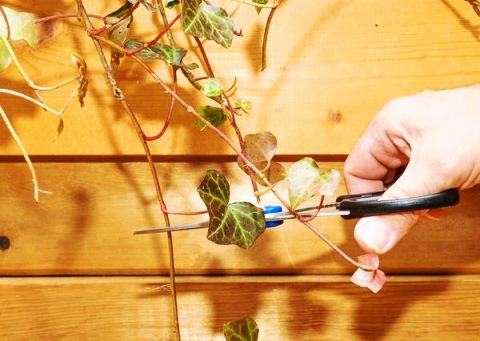
Correct leaf pruning
Although ivy is often found in nature, not everyone can take proper care of it. The owner of this amazing plant should carefully monitor watering, excess growth and soil, and then the plants will thank them with their beautiful branching appearance.
What does green ivy look like?
Hedera is an evergreen liana capable of wrapping around everything, even vertical structures. The culture does not have a powerful trunk. The root system is branched. Separate aerial parts of the root serve to secure ivy to walls, trees and other vertical objects.

Hedera in the wild envelops the trees
The leaves of most species are green. Some are distinguished by white blotches or edging.They can be quite large, and reach a length of 20 cm, or small, which is typical for indoor varieties. They are always dense and leathery specimens with a glossy surface, differing in shape depending on the species.
Hedera is capable of blooming. But the inflorescences are inconspicuous. The flowers are small. They have a greenish tint. After that, small fruits appear. They can also act as a seed for propagation in the wild.
Important! If indoor ivy suddenly bloomed, fruits appeared, they must be carefully cut and destroyed. They are the ones that are poisonous.
It is important to wear gloves and protect the skin from the ingress of harmful "syrup". You can even put on a raincoat. Direct contact can cause redness, blisters and even burns on the body. Excessive swelling can cause coughing.
Why do leaves dry
There are several reasons:
- lack of moisture in the air;
- too hot in the room;
- attacked spider mites, aphids, scale insects;
- a natural process (as the flower grows, it sheds old leaves);
- lack of sunlight;
- the size of the pot is not suitable (too small).
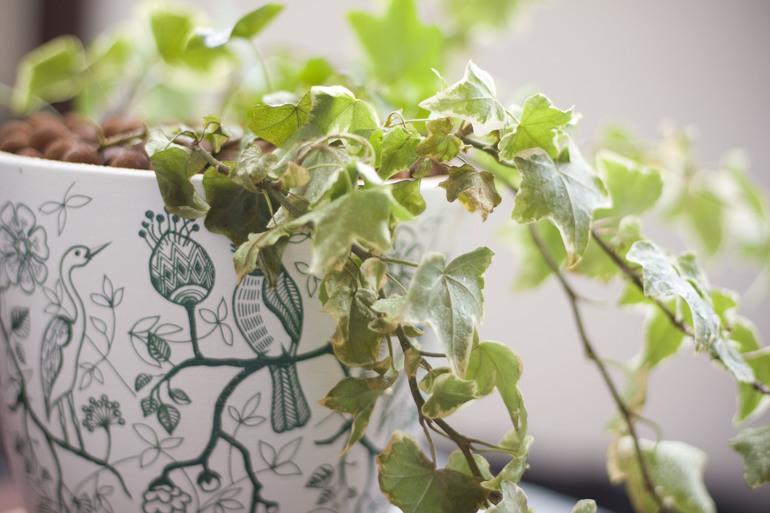
Why does the cheder wither and dry?
How to help a flower?
- In ivy, the roots grow superficially, so the pot is needed not so much deep as wide.
- For lack of moisture, the cheder is sprayed and poured under the shower.
- The problem of lack of light is easy to solve if you put the flower pot in a more illuminated place. Also, from the heat, the plant is taken out into the cool.
Harmful insects grow on weak ivy that is not well cared for.
- One of the pests is a spider mite. Traces of his vital activity are visible on the white lace entangling the leaves, which then turn yellow and dry.
- The appearance of the scale insect is indicated by gray spots on the foliage on the inside. The growth of the plant stops, the leaves turn yellow, dry.
- From aphids, ivy withers, loses foliage.

Spider mite on hedera leaves
If you do not take pest control measures, the plant will die in a short time (from spider mites in 15 days).
For pests, heder is sprayed and watered:
- Aktellik;
- Karbofos;
- Aktara.
The manufacturer's packaging indicates how to use the drug.
Ivy in the country
The best shrubs and trees are always planted at their summer cottage. A curly liana will decorate a place that is used for rest.
How to plant ivy on the site
Many gardeners are interested in how to grow variegated garden ivy. It is better to plant cuttings in spring in breathable and nutritious soil to a depth of 15-20 cm.
Note! With heavy soil, it is necessary to dig a hole a little deeper and make drainage from expanded clay or broken bricks. A young plant must be directed to a support or fence
Watering is carried out moderately so that there is no stagnation of water. You can fertilize the vine with organic feeding once a month. Shoots should be covered before winter to avoid frostbite on stems and roots.
A young plant should be directed to a support or fence. Watering is carried out moderately so that there is no stagnation of water. You can fertilize the vine with organic feeding once a month. Shoots should be covered before winter to avoid frostbite on stems and roots.
Use in landscape design
Evergreen vines attract attention due to the variety of color and shape of the leaves. Designers use the plant to decorate vertical surfaces: Note! When creating a structure, it is necessary to constantly direct the growing shoots in the right direction.
Note! When creating a structure, it is necessary to constantly direct the growing shoots in the right direction.
Combination with other plants
Common garden ivy can be combined with other plants that can embody any design ideas. Liana is planted near roses, flowering shrubs and conifers. As a result, the gardener gets ivy, curling up the wall, which is pleasing to the eye.
How to prevent overgrowth of garden ivy evergreen
Gardeners are not always happy with the intensive growth of the plant, which begins to braid nearby trees and bushes. To get rid of ivy, you need to cut it at the very root, dig up the entire root system and make sure that there are no shoots left on the ground. Herbicides are sometimes used.
Compliance with the rules of care, planting and reproduction will allow you to achieve a good result. Evergreen ivy will grow quickly and beautifully. With the help of the plant, they create an original landscape design, decorating the hedge, other shrubs and even the walls of the house with greenery.
Hedera and its varieties
More than 15 varieties of creeping ivy are known. The plant is found in subtropical groves of Europe, Asia, Africa and even America. The shrub prefers shady forests. Twisting its shoots around tall trees, it can reach a considerable height due to them. Known:
Hedera Variegated
It is considered a homemade variety that prefers to envelop vertical surfaces. Liana-shaped bush, has small foliage with variegated color. It is easy to grow variegated ivy and take care of the plant. Prefers bright rooms for active growth, but without direct sunlight on the leaves. The soil in the pot must always be moist, otherwise the leaves will begin to fall off.
Ivy canary
Differs in the strength and power of the trunk and leaves. The leaf can be up to 20 cm in length. White blotches on the surface are characteristic. It occurs naturally in Portugal and North Africa. The most famous variety is Variegata. The stem is slightly reddish. The leaves are large, with a white-green edging. The flower of the Canary Hedera has a green-yellow color. Small flowers are collected in inflorescences, resembling umbrellas in appearance. Ivy is a poisonous shrub.
The leaves of the Canary variety have an amazing color
Ivy irish
The variety is characterized by rapid growth. Basically, it reaches a height of 12-15 m. Some specimens - 20 m. A distinctive feature of heders is considered to be green leaves with dull areas, which have a characteristic bend. The culture is able to spread very picturesquely along the walls of houses and on the ground, and in a short period of time it can hide a plot of up to nine to ten square meters in its foliage. Globular inflorescences appear in early autumn. Densely pubescent shoots with a reddish edging add decorativeness.
Ivy Hedera Helix Vander
A roomy look that can beautify any interior. You can create a living wall. The main thing is to provide reliable support. The leaves are green and star-shaped. The veins are light, turquoise. You can plant the plant in hanging pots. The soil is suitable for all types of plants.
Note! Helix Vander does not need feeding, he likes diffused lighting. Avoid direct sunlight
Plyushch Pastukhova
The plant is protected in a number of reserves in the Caucasus. It was listed in the Red Book of the Soviet Union. Shoots are thin, light brown in color. Leaves are bright green with sparse stripes below, can reach a length of 10 cm. Odorless. They are round-heart-shaped. In the wild today, Pastukhov's ivy is quite rare. It grows on forest edges and clearings, climbs tall trees.
Ivy variegated
It is considered an indoor subspecies and is popular with florist designers. Looks beautiful in the interior thanks to green leaves with white edging. The foliage is shaped like a triangle. Its size is small, in contrast to the ivy leaves growing on the wall of the house. It is very easy to care for Variegated Ivy.
Ivy Caucasian
The natural habitat of the shrub is the Caucasus, hence the second name of the plant. Liana is distinguished by its strength and strength. It can climb a high support up to 30 m. The leaves are large and more often whole. Length 18-25 cm, width 15-20 cm.Color green. Although there are also varieties interspersed in the form of small spots.

Caucasian hedera has dark berries that appear after flowering
Ivy greenhart
Evergreen aralian plant, reaching a height of 3-6 m. Leaves are bright green with light veins. Reliable fastening on vertical surfaces is carried out with the help of aerial roots. An unpretentious culture used for decorative purposes. It should be planted on loose and humified soil. Winter is going through normally.
Boston ivy
Liana is distinguished by a tree-like trunk, splendor and density. Reaches 20-30 m. Often used for decorative purposes. By autumn, the dark green leaves take on a red and orange hue. The plant is sensitive to low temperatures. The light should be diffused, ivy will suffer from direct sunlight. During the season, the vine can grow by 3-4 m.
Interesting! Unlike English, Field, Colchis and Crimean ivy, Boston does not belong to the Aralia family. He comes from the grape family. From which the plant is popularly called the Maiden ivy grape.
Indoor plant photo and description
Indoor ivy (hedera) is an evergreen liana from the Araliev family. Their habitat is the shady subtropical forests of Europe, America, Asia and North Africa. Thanks to the small roots on the lashes, the plant is able to braid tree trunks, climbing 15-30 meters up. The same roots provide additional nutrition to the entire bush. It was this feature that ensured its active use in landscape design, both for vertical gardening (for example, building facades) and as a ground covering plant, and if we talk about indoor varieties, then in the interior of residential premises.
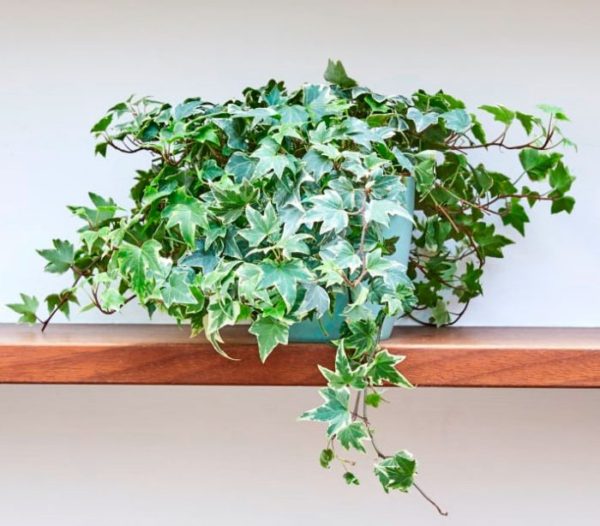
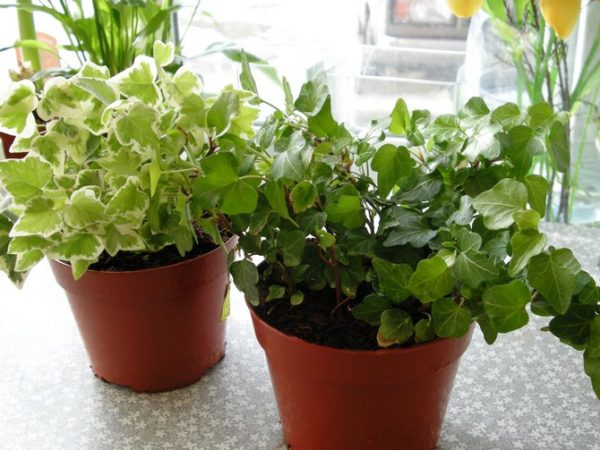
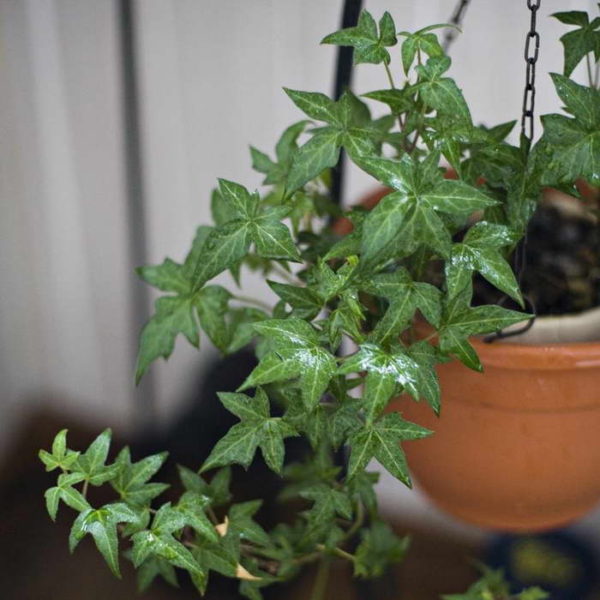
The flowers of the chedera are inconspicuous, besides, it does not bloom at home, so the issue of ivy propagation by seeds is not relevant. But the leaves are a real decoration: three-, five- or seven-lobed, rich green with veins or edging in lighter colors, they literally cover each lash completely.
Magnificent ivy and its types
 Ivy or hedera in Latin is called Hedera helix, which means "curly ivy." The homeland of 15 plant species belonging to the genus Hedera is considered to be the subtropics of Europe, Africa and Asia.
Ivy or hedera in Latin is called Hedera helix, which means "curly ivy." The homeland of 15 plant species belonging to the genus Hedera is considered to be the subtropics of Europe, Africa and Asia.
In nature, these evergreen vines are accustomed to growing in the shade of tree crowns, which explains their ability to endure a lack of light.
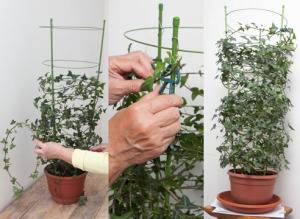 An interesting feature of ivy is that the plant is unable to support the weight of its own leaves. Therefore, it sticks with roots to any surface that is nearby, for example, a wall. To avoid this, you need to provide the ivy with a support in the form of special bamboo or plastic sticks.
An interesting feature of ivy is that the plant is unable to support the weight of its own leaves. Therefore, it sticks with roots to any surface that is nearby, for example, a wall. To avoid this, you need to provide the ivy with a support in the form of special bamboo or plastic sticks.
Due to the fact that with good care, ivy grows long shoots, they can be used for interior decoration. Columns, arches or partitions entwined with flexible branches with leaves of a beautiful form create a special refined comfort in the house.
In indoor floriculture, the following types of heders are most often grown:
- Common ivy (curly);
- Canary ivy;
- Fatskhedera ivy Lise.
Common ivy (climbing) or Hedera helix is an unusually plastic plant, capable of attaching itself to even the slightest irregularities and wrapping around any support in its path.
There are such popular varieties of this plant as:
- Annette with dark green leaves;
- Chicago with small bright green leaves;
- Chicago Variegata - creamy yellow border frames bright green leaves;
- Little Diamond with cream-veined leaves.
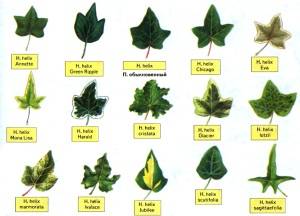 Canary ivy, called Hedera canariensis in Latin, is a species with larger leaves, most often of a variegated color, unable to cling to a support on its own and in need of tying.
Canary ivy, called Hedera canariensis in Latin, is a species with larger leaves, most often of a variegated color, unable to cling to a support on its own and in need of tying.
Its variety Gloire de Marengo is very popular with a combination of cream and green shades on the leaves.
Fatshedera lizei ivy, whose Latin name sounds like Fatshedera lizei, is a new hybrid very popular among flower growers, requiring tying and growing up to 5 meters in height. A very beautiful variety called Variegata with white spots or beige border.
Care activities
Caring for a chedera at home is quite simple. The leaves should be regularly wiped from dirt and dust. This has a good effect not only on culture, but also on air purification.
Pot location
Ivy can grow in a shaded area. But if the variety has variegated plates, then it is best to provide it with good lighting, covering the plant from the direct rays of the sun.

Temperature
Hedera loves cool places to grow and develop. Therefore, in summer, the temperature in the room should not be more than eighteen degrees, and in winter from six to twelve degrees.
In the summer season, the culture is taken out on the balcony or veranda. Drafts or sudden changes in temperature in the room are not terrible for the flower.
Watering
The root system is located near the ivy almost on the surface of the earth, so the plant is demanding on the moisture of the earth. In the spring and summer, it is necessary to water the heder regularly and in large quantities. Drying of a coma, stagnation of liquid in the soil will have a bad effect on the state of the culture. In winter, watering is carried out according to the following rules:
- If the room is warm, then watering is just as systematic and abundant;
- If the room is cool, then watering is reduced to such an extent that the soil does not dry out.
Humidity
If the room has a cool air temperature, then the humidity of the air does not matter for growing a crop. If the air temperature is more than twenty degrees, then you need to systematically spray the leaves and increase the humidity indicator.

Top dressing
In order for ivy to actively develop and grow, it is periodically necessary to add fertilizers to the soil. In the summer, it is enough to use top dressing twice a month. In winter, growth becomes slower due to higher temperatures, so fertilization is applied once a month. If the leaves begin to turn yellow, then there was too much dressing.
Heder ivy propagation
Ivy can be propagated in the simplest way - by cuttings. You can root the cuttings in water.

Transfer
Young individuals are transplanted once a year, and adults twice a year. The container for this should be wide, but with a shallow depth. There should be a good drainage layer at the bottom.
The soil
Ivy is not a demanding substrate for growing. But it is better to include such elements in the soil for transplanting heders: sod soil, leafy soil, sand and peat.
Pruning
During active growth, the heder needs to be pruned in order to preserve the decorative appearance of the vine. Withered and dried leaves, faded buds, old shoots are removed from the surface of the bush. In spring, long shoots are cut off by one third. The trimmed parts can be used for propagation of heders by cuttings.
The header looks great in the interior of an office or apartment.


